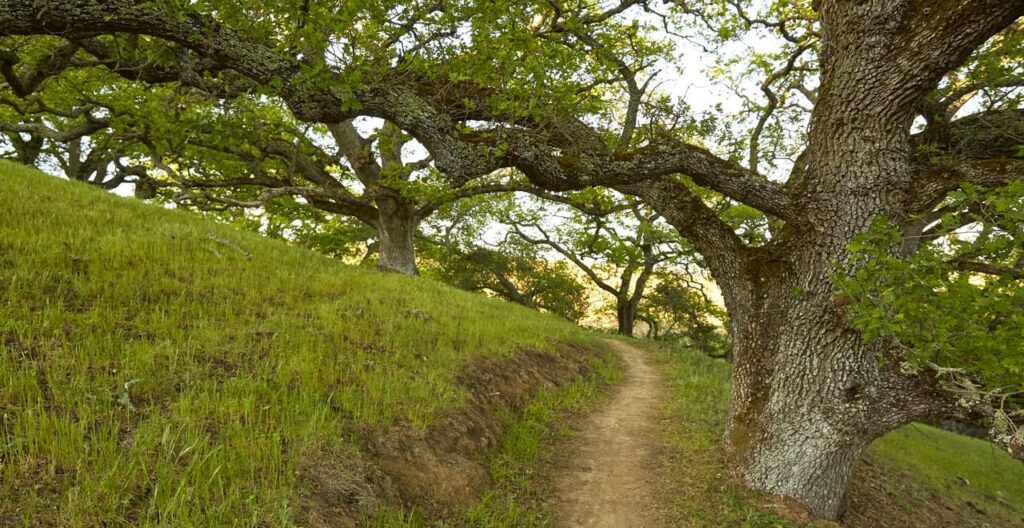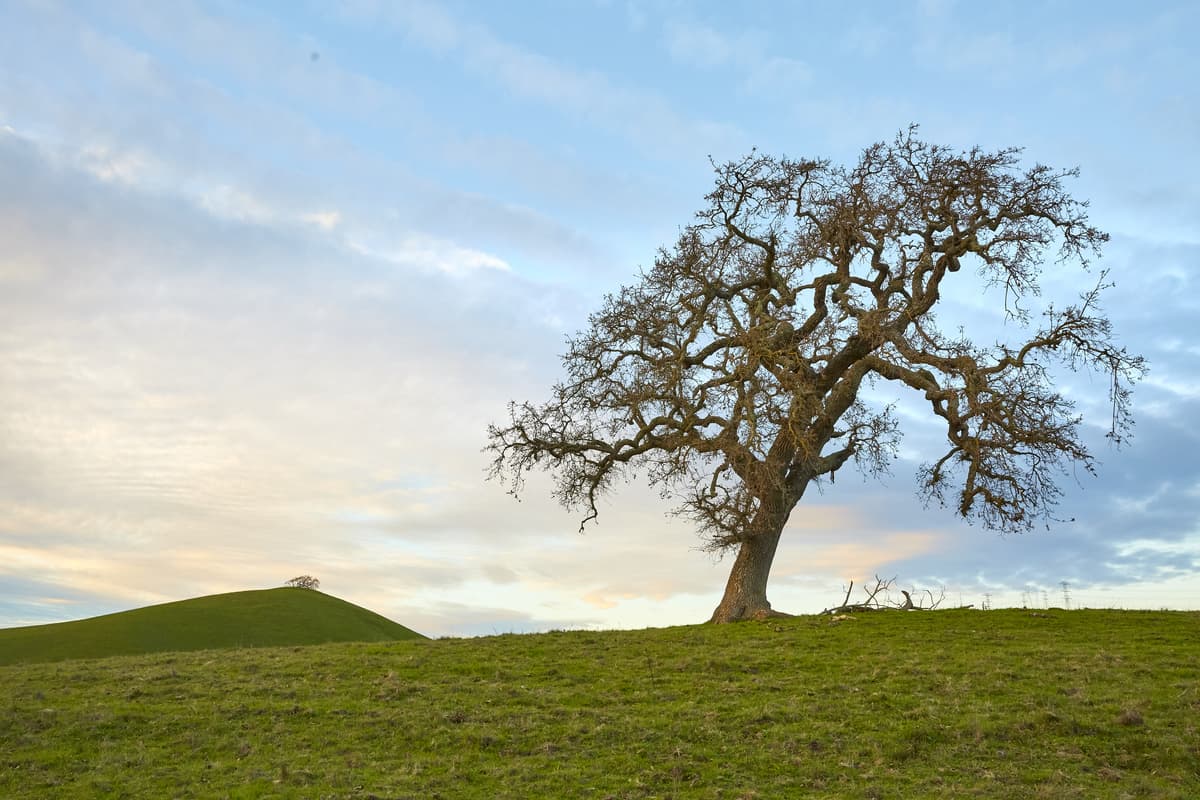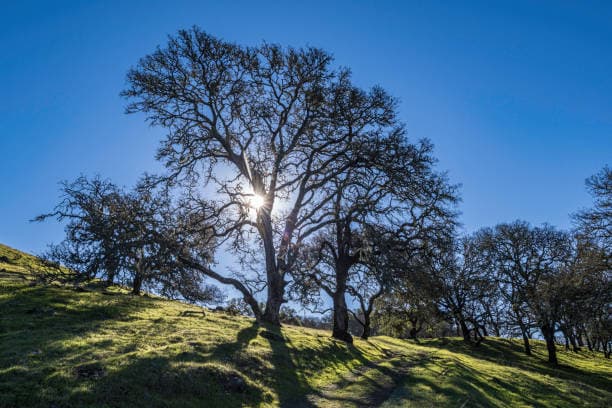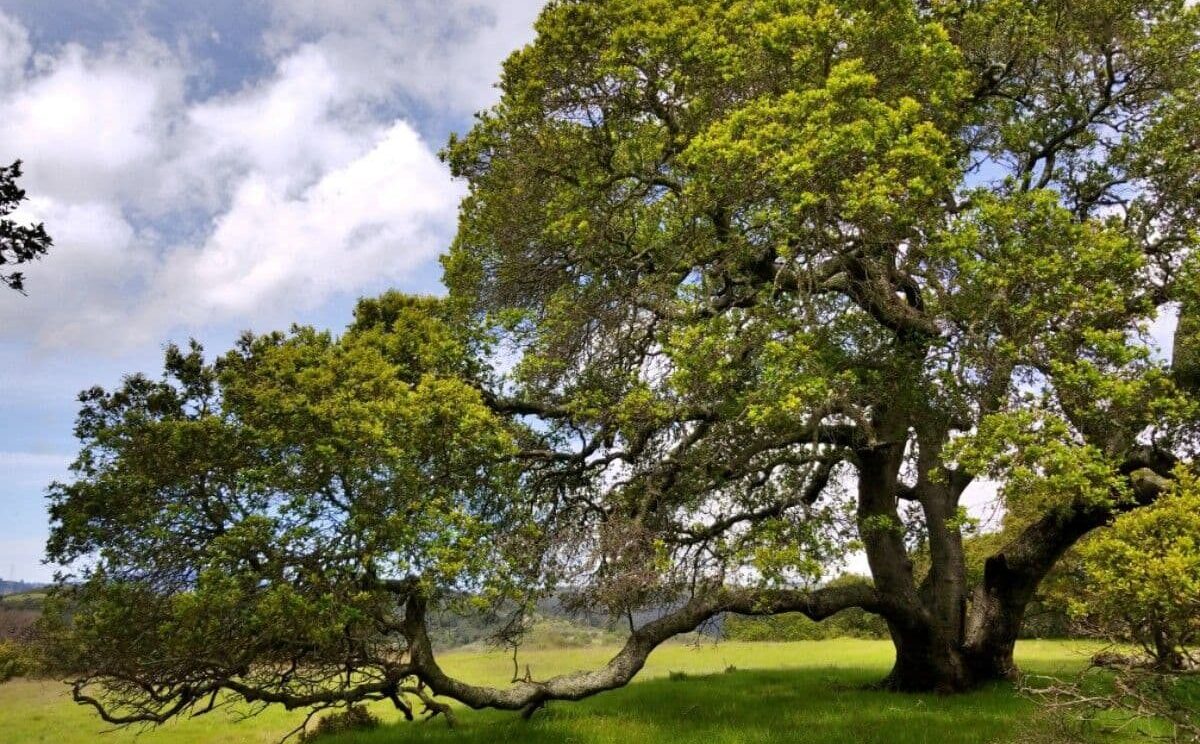The Oaks of JMLT: Ancient Sentinels of the East Bay

Weekend Bike: Flowy Franklin Ridge
June 13, 2025
Outside Updates
September 8, 2025
Step into our oak woodlands and walk through living history
When John Muir wandered the hills that now bear his name, he walked beneath the same towering canopies that shelter us today. Across JMLT's 4,700+ acres of protected East Bay lands, these magnificent trees have been silent witnesses to centuries of change. Today, at least seven native oak species call our properties home, each with its own unique story of survival, adaptation, and wonder.
Valley Oak
Quercus lobata

Valley Oaks are long-lived trees; some mature specimens can survive for up to 600 years.
Valley oaks are the titans of the oak family. They can tower over 100 feet tall with massive trunks exceeding 10 feet in diameter. You'll find these magnificent trees thriving in lower elevations, particularly near seasonal streams and valley floors. They're easy to identify by their deeply lobed, deciduous leaves that transform into brilliant gold each fall and their distinctive "alligator skin" bark with its characteristic rough, blocky texture.
Blue Oak
Quercus douglasii

Blue oaks show their characteristic sparse canopy and blue-green foliage.
California's blue oaks are masters of drought survival, the state's most drought-tolerant deciduous oak. During the brutal 2012-2016 drought, UC Berkeley researchers watched in amazement as blue oak leaves shrank from thumb-size down to barely bigger than your pinky nail. In exceptionally dry years, blue oaks will drop all their leaves and enter complete summer dormancy while still producing acorns. Their expansive root systems penetrate up to 80 feet deep, finding water in rock cracks other trees can't reach.
Coast Live Oak
Quercus agrifolia

Coast live oaks develop the iconic gnarled, twisting forms that have inspired generations of artists
Coast live oaks stand apart as the only California oak truly adapted to coastal living with ingenious adaptations. Their cupped leaves collect precious moisture from fog, and even on the same tree, leaves vary dramatically. Sun-exposed outer leaves are small and thick with multiple photosynthetic layers, while inner canopy leaves are thin, wide, and flat to capture filtered light. Early shipbuilders prized their twisted branches for making specialized joints in sailing vessels.
Black Oak
Quercus kelloggii

Black oak leaves turn brilliant yellow before dropping, transforming north-facing slopes into golden displays.
Black oaks provide some of the most spectacular fall color in the East Bay. These medium-sized deciduous trees produce large, lustrous green leaves during the growing season, then transform north-facing slopes into blazes of golden yellow each autumn.
Look for black oaks mixed with other species on our cooler, moister north and east-facing slopes, where their nearly tropical-looking foliage creates stunning contrast against the darker bark that gives them their name.
Test your Oak IQ
You're looking at an oak tree. What's the first thing you notice about its leaves?
Use these buttons to identify characteristics of the oak tree you're observing
Other Notable Species
Interior live oak (Quercus wislizenii): These evergreen oaks prefer higher elevations and rocky terrain, forming the backbone of many of our hillside oak woodlands. Their smaller, oval leaves and ability to thrive in tougher conditions make them perfectly adapted to our more challenging sites.
Canyon live oak (Quercus chrysolepis): True to their name, canyon live oaks seek out rocky canyons and steep slopes, often growing in seemingly impossible locations. Their golden-backed leaves (chrysolepis means "golden scale") and incredibly hard wood make them one of our most distinctive species.
Quick Oak Viewing Guide - JMLT Properties
Want to see these magnificent oaks in person? Here are some of the best JMLT properties for oak viewing.
Fernandez Ranch
Exceptional oak diversity! These include coast live oak, black oak, Oregon oak, valley oak and blue oak habitats across oak-studded slopes with multiple trail options. All properties offer miles of multi-use trails and are part of or connect with the Bay Area Ridge Trail system.
Mount Wanda
Walk John Muir's historic trails among coast live oaks, blue oaks, and valley oaks where the naturalist himself once wandered.
Carr Ranch
Near Lamorinda, featuring coastal live oak woodlands and sweeping valley views that showcase the East Bay's natural beauty.
Almond Ranch
Stunning oak-bay woodlands along seasonal streams that flow into Alhambra Creek, creating diverse riparian habitat.
Protecting Ancient Ecosystems
These oak woodlands represent one of California's most biodiverse ecosystems, supporting over 300 wildlife species, 370 fungal species, and nearly 5,000 insect species. But they face unprecedented challenges—drought, fire, disease, and development pressures threaten these ancient communities.

When you protect oak woodlands, you preserve not just individual trees but entire communities of interdependent life, from the smallest soil fungi to the largest raptors that nest in their crowns.
JMLT's work protecting thousands of acres of oak woodland helps maintain critical wildlife corridors and ecosystem functions. Our stewardship includes careful fire management, invasive species control, and habitat restoration guided by science and traditional ecological knowledge.
What You Can Do
- Volunteer: Help with habitat restoration and monitoring projects
- Visit Mindfully: Stay on trails and follow Leave No Trace principles
- Support JMLT: Your donations directly fund oak woodland protection and stewardship
These mighty oaks have stood sentinel over the East Bay for centuries, weathering droughts, fires, and floods. With your help, they'll continue to grace our landscapes for centuries to come. 💚

